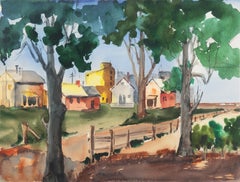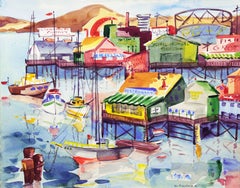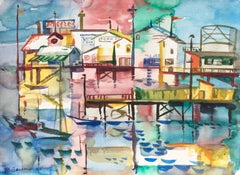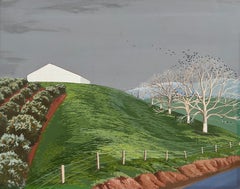Muriel Backman Art
American, 1902-1996
Muriel Backman was born in 1902. She is well-listed in relevant art reference works, and her work is held in public and private collections, including the permanent collection of the San Francisco Public Library.
to
3
7
7
7
Overall Height
to
Overall Width
to
4
3
3
3
3
2
2
1
1
1
1
1
1
1
1
1
1
12
7
5
12
1,776
1,649
373
245
7
7
6
4
3
Period: 1950s
Artist: Muriel Backman
'University Village, Berkeley' Carmel, California, Woman Post Impressionist
By Muriel Backman
Located in Santa Cruz, CA
Signed verso, 'M. Backman' for Muriel Backman (American, 1902-1996), titled 'University Village', dated 1958 and with inscription verso, 'Demonstration painting- horizontal and verti...
Category
1950s Post-Impressionist Muriel Backman Art
Materials
Paper, Watercolor
'Lighthouse at Point Pinos', Pacific Grove, California Woman Post Impressionist
By Muriel Backman
Located in Santa Cruz, CA
Signed lower right, 'M. Backman' for Muriel Backman (American, 1902-1996); additionally signed verso, titled 'Pt. Pinos' and dated 1953.
A bright and fresh watercolor showing a view...
Category
1950s Post-Impressionist Muriel Backman Art
Materials
Watercolor, Gouache, Paper
'Old San Anselmo, California', Woman Post-Impressionist, Crocker Museum
By Muriel Backman
Located in Santa Cruz, CA
Certification of Authenticity stamped verso; titled verso, 'San Anselmo' and dated 1956.
Muriel Backman exhibited widely and with success from the 1930's ...
Category
1950s Modern Muriel Backman Art
Materials
Watercolor, Paper
'Fisherman's Wharf, Monterey', Modernist California Artist, Crocker Art Museum
By Muriel Backman
Located in Santa Cruz, CA
Signed lower right, "M. Backman" for Muriel Backman (American, 1902-1996), titled verso and dated 1955.
A vibrant Modernist work by this notable California woman artist who exhibit...
Category
1950s Post-Impressionist Muriel Backman Art
Materials
Watercolor, Illustration Board, Graphite
'Golden Gate, San Francisco', Bay Area Woman Modernist, Crocker Art Museum
By Muriel Backman
Located in Santa Cruz, CA
Signed lower right "Muriel Backman" for Muriel Durgin Backman (American, 1902-1996) and titled verso "The Cool Gray City".
An elegant mid-century view of the San Francisco skyline a...
Category
1950s Modern Muriel Backman Art
Materials
Watercolor, Gouache, Handmade Paper
'Monterey Pier', California Modernist, Woman Artist, Santa Cruz Art League
By Muriel Backman
Located in Santa Cruz, CA
Signed lower left "Muriel Backman" for Muriel Durgin Backman and dated 1955.
An elegant, Cubist-derived, mid-century view of the old Fisherman's Wha...
Category
1950s American Modern Muriel Backman Art
Materials
Watercolor, Gouache, Handmade Paper
'Fort Bragg Lumber Mill', Woman Artist, California Post-Impressionist
By Muriel Backman
Located in Santa Cruz, CA
Signed lower left "M. Backman" for Muriel Durgin Backman. Titled verso "Union Lumber Co., Fort Bragg- Mendocino, Ca" and painted circa 1955.
A moody, mid-c...
Category
1950s Modern Muriel Backman Art
Materials
Gouache, Handmade Paper, Watercolor
Related Items
Paris Booksellers (Bouquinistes) Along the River Seine
By Lucien Génin
Located in London, GB
'Paris Booksellers Along the River Seine', gouache on paper (circa 1930s), by Lucien Génin. The used-book sellers (bouquinistes) you see along the Seine a...
Category
Early 20th Century Post-Impressionist Muriel Backman Art
Materials
Paper, Gouache
H 12.41 in W 14.18 in D 1.19 in
Orange Grove Landscape
By Dorr Bothwell
Located in Los Angeles, CA
Orange Grove Landscape, 1941, gouache on illustration board, 14 inches x 18 inches (image), 22 x 26 inches (framed) signed and dated lower right, newly framed with museum glazing
...
Category
1940s American Modern Muriel Backman Art
Materials
Gouache, Board
Rare Chaim Gross Watercolor Painting Manhattan Skyscrapers Train NYC WPA Artist
By Chaim Gross
Located in Surfside, FL
This appears to be dated 1927. It came in with a piece dated 1929. A very early, rare work.
Framed 22.5 x 18. Image 14.5 x 9
A great New York city street scene with an El train (elevated subway line) and architectural renderings of buildings.
This is a wonderful piece by one of America's most treasured artists, Chaim Gross. Throughout his lifetime Gross has gone through tragedy and a real test of faith however, he has the unique ability to focus and direct his expression to the most joyful and beautiful works of art, such as the present lot. For more than sixty years Chaim Gross's art has expressed optimistic, affirming themes. His acrobats, cyclists, and mothers and children convey joyfulness, exuberance, love, and intimacy. This aspect of his work
remained consistent with his Hasidic heritage, which teaches that "only in his childlike happiness is man nearest to God." He often used his creative abilities to explore and experiment with media. In his artwork he retains an optimistic philosophy, even when facing somber issues such as war, depression, and the Holocaust.
Chaim Gross (March 17, 1904 – May 5, 1991) was an American sculptor and educator.
Gross was born to a Jewish family in Austrian Galicia, in the village of Wolowa (now known as Mezhgorye, Ukraine), in the Carpathian Mountains. In 1911, his family moved to Kolomyia (which was annexed into the Ukrainian USSR in 1939 and became part of newly independent Ukraine in 1991). When World War I ended, Gross and brother Avrom-Leib went to Budapest to join their older siblings Sarah and Pinkas. Gross applied to and was accepted by the art academy in Budapest and studied under the painter Béla Uitz, though within a year a new regime under Miklos Horthy took over and attempted to expel all Jews and foreigners from the country. After being deported from Hungary, Gross began art studies at the Kunstgewerbeschule in Vienna, Austria shortly before immigrating to the United States in 1921. Gross's studies continued in the United States at the Beaux-Arts Institute of Design, where he studied with Elie Nadelman and others, and at the Art Students League of New York, with Robert Laurent. He also attended the Educational Alliance Art School, studying under Abbo Ostrowsky, at the same time as Moses Soyer and Peter Blume.
In 1926 Gross began teaching at The Educational Alliance, and continued teaching there for the next 50 years. Louise Nevelson was among his students at the Alliance (in 1934), during the time she was transitioning from painting to sculpture. In the late 1920s and early 1930s he exhibited at the Salons of America exhibitions at the Anderson Galleries and, beginning in 1928, at the Whitney Studio Club. In 1929, Gross experimented with printmaking, and created an important group of 15 linocuts and lithographs of landscapes, New York City streets and parks, women in interiors, the circus, and vaudeville. The entire suite is now in the collection of the Philadelphia Museum of Art. Gross returned to the medium of printmaking in the 1960s, and produced approximately 200 works in the medium over the next two decades.
In March 1932 Gross had his first solo exhibition at Gallery 144 in New York City. For a short time they represented Gross, as well as his friends Milton Avery, Moses Soyer, Ahron Ben-Shmuel and others.
Gross was primarily a practitioner of the direct carving method, with the majority of his work being carved from wood. Other direct carvers in early 20th-century American art include William Zorach, Jose de Creeft, and Robert Laurent. Works by Chaim Gross can be found in major museums and private collections throughout the United States, with substantial holdings (27 sculptures) at the Hirshhorn Museum and Sculpture Garden. A key work from this era, now at the Smithsonian American Art Museum, is the 1932 birds-eye maple Acrobatic Performers, which is also only one and one quarter inch thick.
In 1933 Gross joined the government's PWAP (Public Works of Art Project), which transitioned into the WPA (Works Progress Administration), which Gross worked for later in the 1930s. Under these programs Gross taught and demonstrated art, made sculptures that were placed in schools and public colleges, made work for Federal buildings including the Federal Trade Commission Building, and for the France Overseas and Finnish Buildings at the 1939 New York World's Fair. Gross was also recognized during these years with a silver medal at the Exposition universelle de 1937 in Paris, and in 1942, with a purchase prize at the Metropolitan Museum of Art's "Artists for Victory" exhibition for his wood sculpture of famed circus performer Lillian Leitzel.
In 1949 Gross sketched Chaim Weizmann, President of Israel, at several functions in New York City where Weizmann was speaking, Gross completed the bust in bronze later that year. Gross returned to Israel for three months in 1951 (the second of many trips there in the postwar years) to paint a series of 40 watercolors of life in various cities. This series was exhibited at the Jewish Museum (Manhattan) in 1953.
In the 1950s Gross began to make more bronze sculptures alongside his wood and stone pieces, and in 1957 and 1959 he traveled to Rome to work with famed bronze foundries including the Nicci foundry. At the end of the decade Gross was working primarily in bronze which allowed him to create open forms, large-scale works and of course, multiple casts. Gross's large-scale bronze The Family, donated to New York City in 1991 in honor of Mayor Ed Koch, and installed at the Bleecker Street Park at 11th street, is now a fixture of Greenwich Village. In 1959, a survey of Gross's sculpture in wood, stone, and bronze was featured in the exhibit Four American Expressionists curated by Lloyd Goodrich at the Whitney Museum of American Art, with work by Abraham Rattner, Doris Caesar, and Karl Knaths. In 1976, a selection from Gross's important collection of historic African sculpture, formed since the late 1930s, was exhibited at the Worcester Art Museum in the show The Sculptor's Eye: The African Art Collection of Mr. and Mrs. Chaim Gross. Gross was elected into the National Academy of Design as an Associate member, and became a full Academician in 1981. In 1984, he was inducted into the American Academy of Arts and Letters, with Jacob Lawrence and Lukas Foss. In the fall of 1991, Allen Ginsberg gave an important tribute to Gross at the American Academy of Arts and Letters, which is published in their Proceedings. In 1994, Forum Gallery, which now represents the Chaim Gross estate, held a memorial exhibition featuring a sixty-year survey of Gross's work.
Gross was a professor of printmaking and sculpture at both the Educational Alliance and the New School for Social Research in New York City, as well as at the Brooklyn Museum Art School, the MoMA art school, the Art Student's League and the New Art School (which Gross ran briefly with Alexander Dobkin...
Category
Mid-20th Century American Modern Muriel Backman Art
Materials
Paper, Watercolor
The Laughter of Silent Remnants
Located in THOMERY, FR
In "The Laughter of Silent Remnants," Linda Clerget captures the pure emotion of an individual, joyfully exploring the vegetal remnants on a trunk, akin to a child. The artwork, crea...
Category
21st Century and Contemporary Impressionist Muriel Backman Art
Materials
Handmade Paper, Gouache
Purple Cypress Tree - Coastal Fauvist Vertical Landscape
By Karen Druker
Located in Soquel, CA
Brightly colored Fauvist coastal landscape of a vivid purple cypress tree at the edge of the water, under a bright yellow sky and orange sun by Karen Druker (American, 1945). Signed ...
Category
21st Century and Contemporary Fauvist Muriel Backman Art
Materials
Paper, Pastel, Watercolor, Pencil
H 36 in W 28 in D 0.13 in
Isis with the tulipes
Located in THOMERY, FR
This delicate watercolor painting captures the serene beauty of springtime in Linda Clerget's garden. In the center of the composition sits Isis, her beloved cat, surrounded by vibra...
Category
21st Century and Contemporary Fauvist Muriel Backman Art
Materials
Watercolor, Handmade Paper
Wheat Field Harvest, Early 20th Century Figurative Landscape
Located in Soquel, CA
Early 20th century Italian figurative landscape of a traditional wheat field harvest scene, by S. Frosini (Italian, 20th Century). This figurative landscape in gouache depicts in gre...
Category
Early 20th Century Impressionist Muriel Backman Art
Materials
Illustration Board, Gouache
American Modernist Jack Hooper "Fruit Still Life" Original Painting
By Jack Hooper
Located in Arp, TX
Jack Hooper
"Fruit Still Life"
10-1996
Conte crayon and gouache on paper
19.75"x14.25" cherry wood frame with white sides 24.25"x18.25"
Signed and dated in...
Category
1990s American Modern Muriel Backman Art
Materials
Conté, Paper, Gouache
No Reserve
H 18.25 in W 24.35 in
Simka Simkhovitch WPA Artist Oil Painting Gouache American Modernist Powerline
By Simka Simkhovitch
Located in Surfside, FL
Simka Simkhovitch (Russian/American 1893 - 1949)
This came with a small grouping from the artist's family, some were hand signed some were not.
These were studies for larger paintings.
Simka Simkhovitch (Симха Файбусович Симхович) (aka Simka Faibusovich Simkhovich) (Novozybkov, Russia May 21, 1885 O.S./June 2, 1885 N.S.—Greenwich, Connecticut February 25, 1949) was a Ukrainian-Russian Jewish artist and immigrant to the United States. He painted theater scenery in his early career and then had several showings in galleries in New York City. Winning Works Progress Administration (WPA) commissions in the 1930s, he completed murals for the post offices in Jackson, Mississippi and Beaufort, North Carolina. His works are in the permanent collections of the Dallas Museum of Art, the National Museum of American Art and the Whitney Museum of American Art. Born outside Kyiv (Petrograd Ukraine) into a Jewish family who owned a small department store. During a severe case of measles when he was seven, Simcha Simchovitch sketched the views outside his window and decided to become an artist, over his father's objections. Beginning in 1905, he studied at the Grekov Odessa Art School and upon completion of his studies in 1911 received a recommendation to be admitted to the Imperial Academy of Arts. Though he enrolled to begin classes in architecture, painting, and sculpture at the Imperial Academy, he was dropped from the school roster in December because of the quota on the number of Jewish students and drafted into the army. Simchovitch served as a private in the 175th Infantry Regiment Baturyn [ru] until his demobilization in 1912. Re-enrolling in the Imperial Academy, he audited classes.
Simka Simkhovitch exhibited paintings and sculptures in 1918 as part of an exhibition of Jewish artists and in 1919 placed 1st in the competition "The Great Russian Revolution" with a painting called "Russian Revolution" which was hung in the State Museum of Revolution. In 1922, Simkha Simkhovitch exhibited at the International Book Fair in Florence (Italian: Fiera Internazionale del Libro di Firenze). In 1924, Simkhovitch came to the United States to make illustrations for Soviet textbooks and decided to immigrate instead. Initially he supported himself by doing commercial art and a few portrait commissions. In 1927, he was hired to paint a screen for a scene in the play "The Command to Love" by Fritz Gottwald and Rudolph Lothar which was playing at the Longacre Theatre on Broadway. Art dealers began clamoring for the screen and Simkhovitch began a career as a screen painter for the theater. Catching the attention of the screenwriter, Ernest Pascal, he worked as an illustrator for Pascal, who then introduced him to gallery owner, Marie Sterner. Simkhovitch's works appeared at the Marie Sterner Gallery beginning with a 1927 exhibit and were repeated the following year. Simkhovitch had an exhibit in 1929 at Sterner's on circus paintings. In 1931, he held a showing of works at the Helen Hackett Gallery, in New York City and later that same year he was one of the featured artists of a special exhibit in San Francisco at the California Palace of the Legion of Honor in Lincoln Park. The exhibit was coordinated by Marie Sterner and included four watercolors, including one titled "Nudes". He is of the generation of Russian Soviet artists such as Isaac Pailes, Serge Charchoune, Marc Chagall, Chana Orloff, Isaac Ilyich Levitan, and Ossip Zadkine.
In 1936, Simkhovitch was selected to complete the mural for the WPA Post office project in Jackson, Mississippi. The mural was hung in the post office and courthouse in 1938 depicted a plantation theme. Painted on the wall behind the judge’s bench, “Pursuits of Life in Mississippi”, a depiction of black workers engaged in manual labor amid scenes of white professionals and socialites, was eventually covered over in later years during renovations due to its stereotypical African American imagery. Simka painted what he thought was typical of Jackson. His impression of pre-civil rights Mississippi was evidently Greek Revival column houses, weeping willow trees, working class families, and the oppression of African Americans. He painted African American men picking cotton, while a white man took account of the harvest and a white judge advised a white family, calling it Pursuits of Life in Mississippi.
Though clearly endorsed by the government and initially generally well-received, the mural soon raised concerns with locals as the climate toward racial segregation began to change. The main concern was whether depictions that show African Americans in subjugated societal roles should be featured in a courtroom. The following year, his painting "Holiday" won praise at an exhibition in Lincoln, Nebraska. In 1940, Simkhovitch's second WPA post office project was completed when four murals, "The Cape Lookout Lighthouse and the Orville W. Mail Boat", "The Wreck of the Crissie Wright", "Sand Ponies" and "Canada Geese" were installed in Beaufort, North Carolina. The works were commissioned in 1938 and did not generate the controversy that the Jackson mural had. The main mural is "The Wreck of the Crissie Wright" and depicts a shipwreck which had occurred in Beaufort in 1866. "The Cape Lookout Lighthouse and the Orville W. Mail Boat" depicted the lighthouse built in 1859 and the mail boat that was running mail during the time which Simkhovitch was there. The boat ran mail for the area until 1957. "Sand Ponies" shows the wild horses common to the North Carolina barrier islands and "Canada Geese" showed the importance of hunting and fishing in the area. All four murals were restored in the 1990s by Elisabeth Speight, daughter of two other WPA muralists, Francis Speight...
Category
1930s American Modern Muriel Backman Art
Materials
Gouache, Oil, Board
Rue Étienne Marcel, Paris, France
By Henri Grenier
Located in Atlanta, GA
One of my favorite French Fauvist painters, Henri Grenier (1882 - 1940), masterfully captures the energy of the turn-of-the-century Boulevard Saint-Germain in this exciting work on p...
Category
Early 20th Century Fauvist Muriel Backman Art
Materials
Gouache
Half Dome in Pastel Colors, Yosemite National Park Fauvist Landscape Watercolor
By Karen Druker
Located in Soquel, CA
Bright Fauvist landscape of Half Dome in Yosemite National Park, with beautiful use of color by Karen Druker (American, 1945). Signed "Druker" in the lower right corner. Presented in...
Category
21st Century and Contemporary Fauvist Muriel Backman Art
Materials
Paper, Pastel, Watercolor
Karen DrukerHalf Dome in Pastel Colors, Yosemite National Park Fauvist Landscape Watercolor, c. 2010
H 28 in W 36 in D 0.13 in
Trout stream in Oxfordshire
By John Newberry
Located in Harkstead, GB
A lovely vibrant watercolour capturing a shimmering English river
John Newberry (born 1934)
Stream at Wytham, Oxford
Signed
Watercolour
4¼ x 5¾ inches unframed
9 x 11 inches with fr...
Category
1990s Modern Muriel Backman Art
Materials
Paper, Watercolor
Muriel Backman art for sale on 1stDibs.
Find a wide variety of authentic Muriel Backman art available for sale on 1stDibs. You can also browse by medium to find art by Muriel Backman in paint, watercolor, paper and more. Much of the original work by this artist or collective was created during the 20th century and is mostly associated with the modern style. Not every interior allows for large Muriel Backman art, so small editions measuring 20 inches across are available. Customers who are interested in this artist might also find the work of John Cuthbert Hare, Karen Druker, and Janet Ament De La Roche. Muriel Backman art prices can differ depending upon medium, time period and other attributes. On 1stDibs, the price for these items starts at $760 and tops out at $2,750, while the average work can sell for $2,125.







